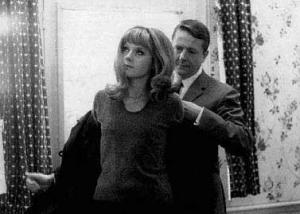In the fifties, at the height of the Cold War, the style of French cinema, takes a connotation of all documentary joined the dialogues for most idealized, this is the birth of the Nouvelle Vague or New Wave.
Just this idealistic way of the Nouvelle Vague does a kind of cinema that is completely detached from the French daily life.
This movement was grateful to represent the immediacy of becoming, thicker films of this period were shot with luck means, including houses and roads, but it is these characteristics that have made remarkable diaries of a new generation, restless and nonchalant.
The most famous directors, as well as the founders of this movement are: Fronçois Truffault, Jean-Luc Godard, Claude Chabrol and Eric Rohmer, born so, a group of friends and movie fans with a great knowledge about it.
La Cinémathèque Française was very important for these kids, who often participated in discussions on cinema and kept there even more often went there to see the films for general canon were now believed invisible, for the most part were the films by American war, like Hitchcock and Hawks.
As Godard himself said, the goal of the Nouvelle Vague, was to capture “the splendor of the true” for this film were deprived of everything he could to be the film “artificial“: no projectors, no expensive equipment, nothing complex backdrops, films were instead filmed in daylight, on the street or in the homes of directors, the shooting was done with the cameras in hand and often the actors were friends of the filmmakers themselves.
Some of the most important films are: Effect of Night by Truffault; Until the Last Breath of Godard, Marker’s La Jetée, a film that was later inspired the Army of the 12 Monkeys by Terry Gilliam, and Le beau Serge film directed by Chabrol and considered the first film of this movement.
This movement has influenced the American cinema, filmmakers were many who wanted to pay tribute, first of all Quentin Tarantino with the episodic film Four Rooms.
La Nouvelle Vague
Negli anni cinquanta, nel pieno della guerra fredda, lo stile del cinema francese, prende una connotazione del tutto documentaristica unito a dei dialoghi per la maggior parte idealizzati, questa è la nascita della Nouvelle Vague o nuova onda.
Proprio questo modo idealistico fa della Nouvelle Vague un tipo di cinema totalmente distaccato rispetto alla vita quotidiana francese.
Questo movimento è stato in grato di rappresentare l’immediatezza del divenire; spesso i film di questo periodo erano girati con mezzi fortuna, tra case e strade, ma proprio queste caratteristiche così singolari ne hanno fatto dei diari intimi di una nuova generazione, inquieta e disinvolta.
I registi più famosi, nonchè i fondatori di questo movimento sono: Fronçois Truffault, Jean-Luc Godard, Claude Chabrol ed Eric Rohmer; nascono così, un gruppo di amici appassionati di cinema e con una grande conoscenza al riguardo.
La Cinémathèque Française fu molto importante per questi ragazzi, che spesso partecipavano ai dibattiti sul cinema ivi tenuti e che ancora più spesso vi si recavano per vedere quei film che per canone generale erano ormai ritenuti invisibili, per lo più erano i film dei registi americani del dopoguerra, come Hitchcock ed Hawks.
Come affermò lo stesso Godard, l’obbiettivo della Nouvelle Vague, era quello di catturare “lo splendore dal vero“, per questo le pellicole venivano private di tutto ciò che poteva far risultare il film “artificiale” : niente proiettori, niente costose attrezzature, niente complesse scenografie, i film venivano invece girati alla luce del giorno, per strada o nelle abitazioni dei registi, le riprese erano fatte con delle telecamere a mano e spesso gli attori erano amici degli stessi registi.
Alcuni dei film più importanti sono: Effetto Notte di Truffault; Fino all’Ultimo Respiro di Godard; La Jetée di Marker, film che poi fu di ispirazione all’Esercito delle 12 Scimmie di Terry Gilliam; e Le beau Serge film diretto da Chabrol e considerato il primo film di questo movimento.
Questo movimento ha influenzato molto il cinema americano, sono stati in molti i registi che gli hanno voluto rendere omaggio, primo fra tutti Quentin Tarantino con il film ad episodi Four Rooms.
Michela

















